My sewing machine has lots of feet. I’ve used some of them–a lot. Some I don’t remember ever using and am not sure what exactly they do. When I got this machine (Bernina) about 26 years ago, I took a class to learn how to operate it because it was quite different from my old machine (a Kenmore). I know they must have at least talked about all the different presser feet because I have notes written on that page in my manual. So I got curious this week to finally find out what else I can do because of all these extra feet I have for my machine. I chose to start with the darning foot.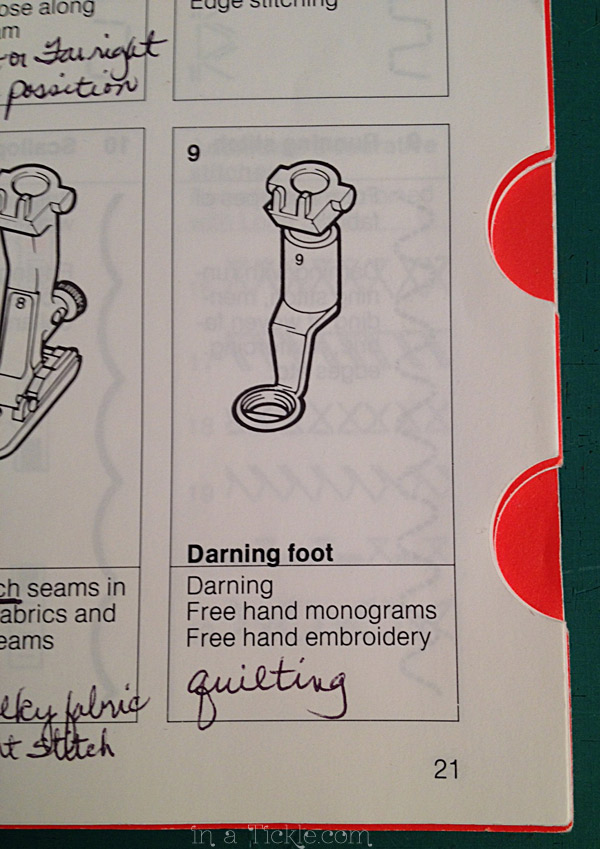 I know darning means repairing garments and other items made from textiles. I have darned rips in jeans before, but just used my regular straight/zig-zag foot. And my grandma used to darn socks (by hand) but I usually toss out my socks with holes. Free hand monograms, free hand embroidery and quilting had me intrigued. So I started searching online to see how to use my darning foot for those sewing activities. Soon I was coming across the term “free motion quilting” in connection with the darning foot. That looked like fun! This website, A few Scraps, was very helpful in explaining the how to’s as well as giving lots of creative ideas.
I know darning means repairing garments and other items made from textiles. I have darned rips in jeans before, but just used my regular straight/zig-zag foot. And my grandma used to darn socks (by hand) but I usually toss out my socks with holes. Free hand monograms, free hand embroidery and quilting had me intrigued. So I started searching online to see how to use my darning foot for those sewing activities. Soon I was coming across the term “free motion quilting” in connection with the darning foot. That looked like fun! This website, A few Scraps, was very helpful in explaining the how to’s as well as giving lots of creative ideas.
To begin the process of free motion quilting, I needed to “prep” my machine. 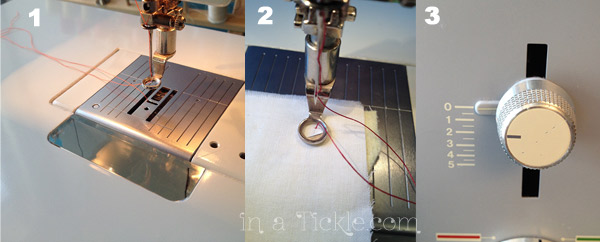 1. Attach the darning foot to the machine. Lower the feed dogs. Attach the “sewing table” to the free arm of the machine. (This allows more flat surface on which you move your fabric around. If your machine has one, I highly recommend using it.)
1. Attach the darning foot to the machine. Lower the feed dogs. Attach the “sewing table” to the free arm of the machine. (This allows more flat surface on which you move your fabric around. If your machine has one, I highly recommend using it.)
2. Take one stitch into the fabric with the needle and pull the upper thread until the lower bobbin thread pulls to the top side of your fabric.
3. Make sure the machine stitch length is set to 0.
I followed the practice stitching suggestions to get the feel of free motion stitching. When you are used to stitching forwards or backwards, with the machine feeding the fabric under the needle consistently, it really takes practice to get used to the feel of you being in control. The needle will go up and down as you push the pedal, but the fabric won’t move unless you make it move. And you are not limited to forward or backward. You can go sideways or in circles or wherever you want to go! You also determine the stitch length by how much you move the fabric. I also found it easier to stitch faster rather than slowly–it made for smoother stitches.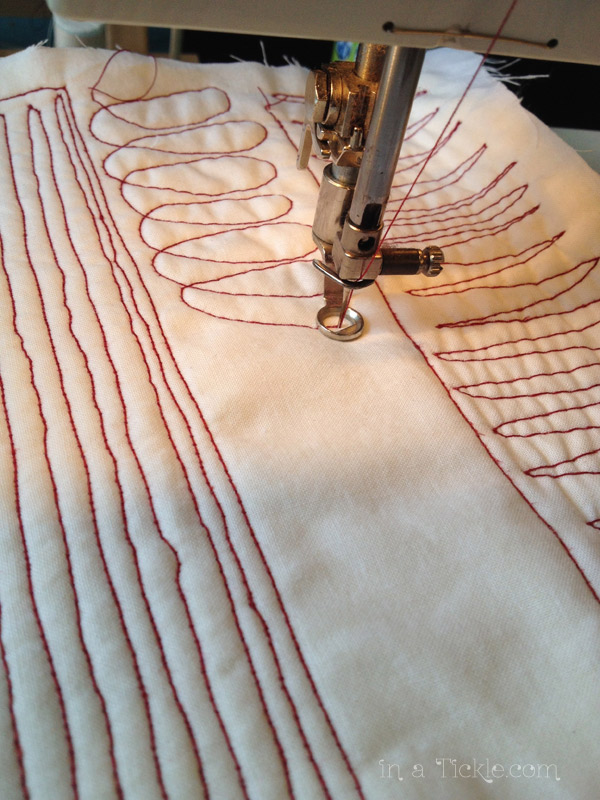
 After reading through all the possibilities of designs to try, I decided to fix another layer sandwich of fabric to quilt. I wanted to completely fill my sampler with free motion sewing doodles.
After reading through all the possibilities of designs to try, I decided to fix another layer sandwich of fabric to quilt. I wanted to completely fill my sampler with free motion sewing doodles.
To help visualize what this process is, think of it this way. Pretend you have a marking pen in one hand (just hold it perfectly still straight up and down.) Now move the paper around under the pen to draw your design. That is what you are doing with the machine. The needle is your pen and you are moving the fabric (paper) around under it to make your designs.
I did not draw any lines on my fabric ahead of time, I just freehanded the doodles. I even tried some cursive writing! It was so much fun. 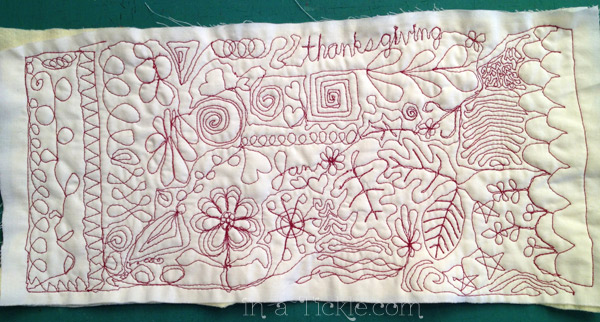 I wondered if I could do the same process on heavy paper for possible card making designs. (Remember to switch out the sewing machine needle for an old needle when you start sewing on paper!)
I wondered if I could do the same process on heavy paper for possible card making designs. (Remember to switch out the sewing machine needle for an old needle when you start sewing on paper!) It works, but is not as easy as sewing on the fabric. The stitches can not be too close together or the paper holes tear through. You also cannot go back over previous stitching on paper like you can on fabric. The thread pulls out of the holes. See my stitching on the letter “a”.
It works, but is not as easy as sewing on the fabric. The stitches can not be too close together or the paper holes tear through. You also cannot go back over previous stitching on paper like you can on fabric. The thread pulls out of the holes. See my stitching on the letter “a”.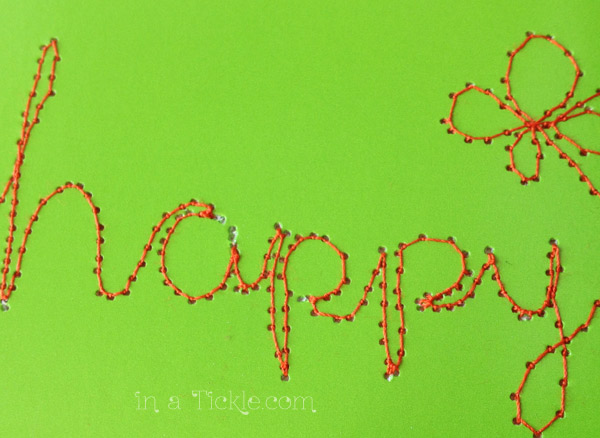 And this is what the back side of the paper looked like:
And this is what the back side of the paper looked like: Check out the feet that came with your sewing machine. Do you have a darning foot? Yours may not look like mine. There are many different styles of darning feet depending on the machine, but they will have some sort of O or C shape for the needle to go through. Practice making sewing doodles. You just may find it sparks lots of creative ideas for future sewing projects or card making projects.
Check out the feet that came with your sewing machine. Do you have a darning foot? Yours may not look like mine. There are many different styles of darning feet depending on the machine, but they will have some sort of O or C shape for the needle to go through. Practice making sewing doodles. You just may find it sparks lots of creative ideas for future sewing projects or card making projects.
Remember that fall fabric I created the other day? I can’t wait to show you what I am doing with that. Hint: It just might have some free motion quilting on it. Stay tuned.
